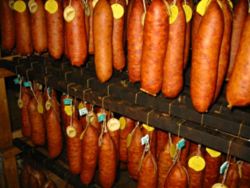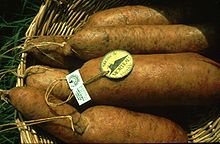Morteau sausage
 Morteau sausage being smoked | |
| Alternative names | Belle de Morteau |
|---|---|
| Type | Sausage |
| Course | Main |
| Place of origin | French |
| Region or state | Europe |
| Main ingredients | pork |

The Morteau sausage (French: saucisse de Morteau; also known as the Belle de Morteau) is a traditional smoked sausage[1] from the Franche-Comté French historical region and take its name from the city of Morteau[2] in the Doubs department. It is smoked in traditional pyramidal chimneys, called "tuyés".[1] It is a strongly flavoured and very dense uncooked sausage.
It is produced on the plateau and in the mountains of the Jura mountains in the Doubs at an altitude greater than 600 m (2,000 ft).[1] The city of Morteau is at the centre of this artisanal industry.
Morteau sausage is produced using only pork from the Franche-Comté region, because in this mountainous region the animals are fattened traditionally. In addition, to be permitted to use the label "Saucisse de Morteau", the sausages must be smoked for at least 48 hours with sawdust from conifer and juniper within the tuyé. It is not cooked, however, as the combustion is accompanied by a strong current of air.
The Morteau sausage is protected by the European Union's PGI[3] label, which guarantees its quality, origin and method of preparation as a regional French specialty. Authentic Morteau typically comes with a metal tag as well as a small wooden stick wrapped around the end of the link.
See also
[edit]References
[edit]- ^ a b c "French Jura wine and cheese, French gastronomy in the Franche-Comte region". www.franche-comte.org. 2008-11-20. Archived from the original on 2008-11-20. Retrieved 2019-05-22.
- ^ "Mairie de Morteau - Savoir-faire et tradition". www.morteau.org. Retrieved 2019-05-22.
- ^ "PGI request for "Saucisse de Morteau"" (PDF). agriculture.gouv.fr. 2007-09-26. Archived from the original (PDF) on 2007-09-26. Retrieved 2019-05-22.
External links
[edit]| Overview | |||||
|---|---|---|---|---|---|
| Fresh sausage | |||||
| Dry sausage |
| ||||
| Smoked sausage | |||||
| Cooked sausage | |||||
| Cooked smoked sausage | |||||
| Precooked sausage | |||||
| Grilled sausage | |||||
| Related articles | |||||
Text is available under the CC BY-SA 4.0 license; additional terms may apply.
Images, videos and audio are available under their respective licenses.

